1lumen selects and reviews products personally. We may earn affiliate commissions through our links, which help support our testing.
Silva Spectra A review

Silva Spectra specifications
| Brand/model | Silva Spectra A |
|---|---|
| Flashlight category | Bike light / helmet light / headlamp |
| LED | 8*CREE XHP50.2 |
| Max. output | 10,000 Lumens |
| Max. beam distance | 310 meters |
| Max. beam intensity | N/A |
| Battery config. | Battery pack 96Wh |
| Onboard charging | Proprietary power adapter |
| Modes | 5 |
| Blinkies | N/A |
| Waterproof | IPX5 |
| Review date | April 2024 |
Review intro:
After reviewing some high power bike lights / headlamps, I can notice a trend. Most of these lights are multi-purpose, and that’s smart. You are not stuck to 1 way of using, like a normal headlamp would be.
Instead, they can be used by attaching the light to a handlebar, helmet or just on your head. And with this versatility, you will be able to please more buyers.. or get more buyers.
The Silva Spectra had been on my wish list for quite some time, when I was looking for the brightest headlamp on the planet. So far, we reviewed the Olight H67 (hard to get) and the Magicshine Monteer 12000. So let’s find out if the Spectra A is something worth considering.
What’s in the package
For a $600+ headlamp/bike light, you would probably expect some fancy packaging, and fortunately, the Silva Spectra does not disappoint in that regard. However, some of their optional accessories are shipped without a box. So this is what I got in my Silva Spectra A box:
- The Silva Spectra light unit (with 8*XHP50.2)
- Battery pack 96Wh
- Power adapter (with 3 different adapters, US, UK, EU)
- Bluetooth remote
- Extension cable
- Helmet mount (with 1 double adhesive pad, 1 friction pad, and 2 straps)
- Little booklet (kind of useless)
Note: it depends on where you buy your kit, which may have different accessories! Make sure you double check the seller’s listing to know what you get. I have seen several sellers providing different accessories. There is also the Silva Spectra O kit, which is shipped with the headband kit.
I made the mistake of thinking my kit included the headset, but it wasn’t. So I ordered the headband after my additional order, which was not cheap. I will talk a bit more about the different optional accessories below.



Flashlight in use, Build Quality, and Warranty
There are 2 different Silva Spectra kits, and the one I got is the Silva Spectra A, which includes a helmet attachment kit. But if you buy the Silva Spectra O kit, you get a headband instead.
According the Swedish Silva website, the A stands for Action, and the O stands for Orienteering. However, according to the Canadian Silva website, the letter A stands for Adventure. To me, that doesnt really matter, but what matter is that the included accessories are so different. So make sure you know what you are ordering, and what’s included!
The Canadian Spectra A includes a Bar mount kit, on top of the other accessories. A little strange in my opinion. It would be better if they had given that another name, like Spectra B (for biking) or something along those lines.
Anyway, with all these kits you get the same light unit, as well as the same 96Wh battery pack. But on top of the standard accessories, there are plenty of optional accessories. And here’s what you can get separately:
- Spectra battery harness
- Spectra storage bag
- Spectra Go Pro mount
- Spectra headband (which I also bought for testing purposes)
- Spectra bike handelbar mount kit
- Spectra double battery connector (for connecting 2 battery packs)
- Spectra helmet mount (included in my kit)
- Spectra extension cable (included in my kit)
- Spectra bluetooth remote control (included in my kit)
- Spectra charger adapter (included in my kit)
- Spectra battery (included in my kit)
- Spectra battery sleeve (for hanging your battery pack to your bike frame)
I bought the headmount (headband) separately, so I could test the headlamp option better.
The lamp unit can be mounted on the head mount, helmet mount, bike mount, or Gopro mount, so it makes it extremely versatile. For this test, I mainly used the headlamp unit. However, I would recommend getting the harness, because the battery pack is pretty heavy.
The lamp unit has a tiny screw on the side where you can adjust the tilt angle of this head unit.
For power, you need to use the switches on the lamp unit, and then you can use the remote for changing modes and turning the light off. I enquired at Silva, whether it was possible to turn the light ON with the remote switch, and it was not. This can be quite a problem in my opinion, because a long -press will turn the light off, but you can’t put it back on. You could get in complete darkness by accident, if you pressed the switch too long, and you had no way of turning it back on with the remote switch.
The cable connected to the battery pack is relatively short (60cm / 23.6 in / 1.96 ft), so you really need to use the extension cable (95cm / 3.11 ft) in almost every case. All cable have their unique connectors, which makes it easy to attach, but not so easy to detach. You need to be careful not to pull the cables, but just the connectors.
The cables also feel like they are just shells, and not solid cables. They probably have a good reason for that, probably so that it could slightly be extended when on pressure.
The light unit itself has 2 switches, 1 slightly protruding (with a + symbol), and the other not (with a – symbol). It’s pretty obvious what they mean, because the + will increase the brightness, and the – decreases the brightness. The + is also used to power on, while the – is used to power off.. Not vise versa.
While the light is on, you can use the Bluetooth remote switch to change modes. It has similar switches as the main light unit with a + and -, having the same functionality. But you can’t use it to power the light on, but change mode, and turn the light off. I reached out to Silva to request this as a feature in their future builds. The switch comes with a wristband, so you can attach it to your wrist. But I’ve noticed that there is some kind of delay between the remote control and the mode switching. This could lead to potentially pressing the – switch just slightly too long, turning the light off.
On the side of this Bluetooth controller there are 5 little LEDs that are used for indicating the battery level. I like that quite a bit.. This controller has a USB-C port, for charging the small built-in battery.
With all the optional accessories, you can basically use this for a large amount of activities, ranging, from night skiing, hiking, biking, to camping, or trekking.
The headmount (headlamp) was purchased afterwards, because that’s what I wanted to test. And it’s pretty large, and shipped without any packaging. Yes, that might save on shipping cost, but for the price, I think some kind of packaging would have been appreciated. It’s 40 EUR for just the head mount, excluding the battery harness which is kind of required, or you need something like a backpack or hip bag.
It’s pretty big, and it has 3 adjustable straps. But with the weight and size of the light unit, I think this is the only size you should expect. It’s not lightweight by any stretch of the imagination.
There is a tiny booklet included in the package, but it is very minimal, and it also notes the full version is visible online.
Warranty according to their full manual:
Silva warrants that, for a period of two (2) years*, your Silva Product will be substantially free of defects in materials and workmanship under normal use. Silva’s liability under this warranty is limited to repairing or replacing the product. This limited warranty extends only to the original purchaser. If the Product proves defective during the Warranty Period, please contact the original place of purchase. Make sure to have your proof of purchase on hand when returning the product. Returns cannot be processed without the original proof of purchase. This warranty does not apply if the Product has been altered, not been installed, operated, repaired, or maintained in accordance with instructions supplied by Silva, or has been subjected to abnormal physical or electrical stress, misuse, negligence or accident. Neither does the warranty cover normal wear and tear. Silva is not responsible for any consequences, direct or indirect, or damage resultant from use of this product. In no event, will Silva’s liability exceed the amount paid by you for the product. Some jurisdictions do not allow the exclusion or limitation of incidental or consequential damages, so the above limitation or exclusion may not apply to you. This Warranty is valid and may be processed only in the country of purchase.
- Batteries: 1 year













LED, Lens, Bezel, Beam, and Reflector
Silva does not hide the LEDs they are using with these Spectra headlamps. No, they mention it very clearly on their website. And they are 8* CREE XHP50.2’s, to reach a claimed output of 10,000 lumens.
And of course we tested that, so please scroll down for our lumen output measurements. But let’s quickly look at how the headlamp performs in terms of beam quality.
The 8 LEDs are mounted inside the lamp unit with individual TIR optics. They produce a very bright hotspot, with a smooth transition to spill. This is something I personally enjoy, instead of a harsh transition that would make you feel like being in a tunnel.
We all know that XHP50.2 do not have the nicest beam qualities, but having 8 of them, behind TIR optics, the beam itself isn’t too bad.
Spectral measurements:
I used a Sekonic C800 spectrometer to measure the headlamp at 5 meters distance. I measured Level 1 (lowest), Level 3, and Level 5 (highest).
| Mode: | CCT: | CRI Ra: | duv | TM30 Rf | TM30 Rg |
|---|---|---|---|---|---|
| Level 1 | 5741K | 71.2 | 0.0080 | 74 | 92 |
| Level 3 | 5902K | 70.9 | 0.0057 | 72 | 93 |
| Level 5 | 6267K | 71.4 | 0.0014 | 71 | 95 |
The higher the output, the cooler the beam, but it stays well below 6500K, so I really don’t care about this being cold white. And the higher the output, the closer the tint is to ideal, going from a duv of 0.0080 to just 0.0014. A positive duv of 0.0080 means that the beam it slightly on the green side of tints, while a negative duv would be on the pinkish side.





Dimensions and its competition
Dimensions:
| Spectra Silva | Millimeters | Inches |
|---|---|---|
| Lamp unit width | 72 mm | 2.8 in |
| Lamp unit height | 69 mm | 2.7 in |
| Lamp unit depth | 34 mm | 1.3 in |
| Battery pack | 165mm*80mm*25mm | 6.5*3.15*0.99in |
Dimensions are rounded to the nearest millimeter and the nearest tenth of an Inch.
Weight:
| Spectra Silva | Weight in grams | Weight in oz. |
|---|---|---|
| Battery pack: | 544g | 19.2oz |
| Lamp unit | 228 g | 8 oz |
| Headband | 64 g | 2.3 oz |
Weight is rounded to the nearest gram and tenth of an Oz.
Silva Spectra Headlamp comparison
Size compared to other headlamps
Group 1, from left to right: Silva Spectra, Magicshine Monteer 12000, Olight H67

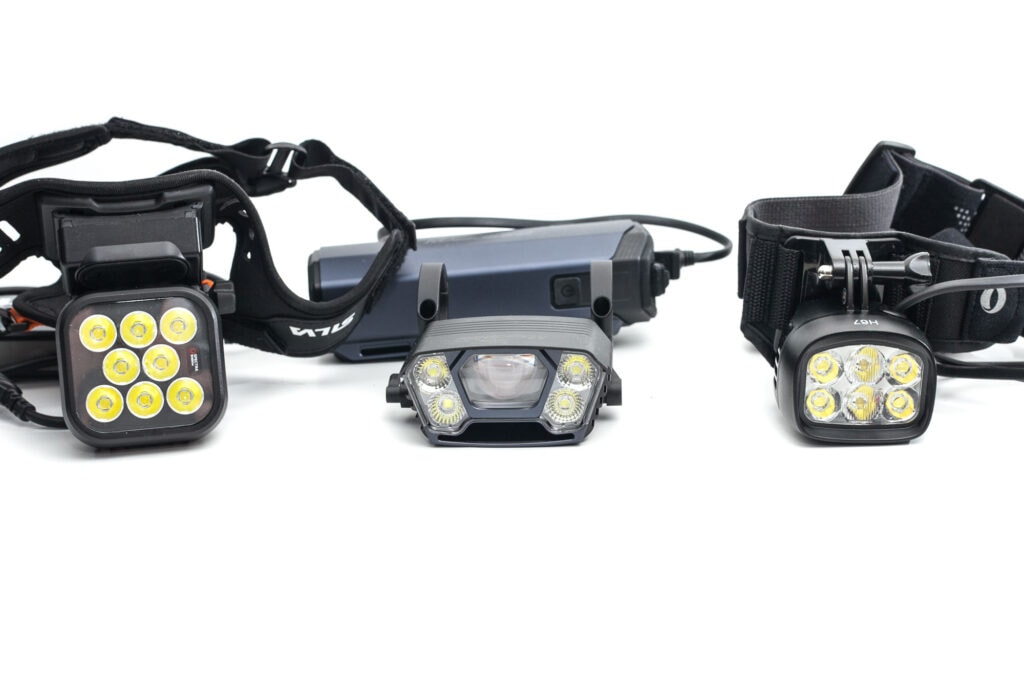
Silva Spectra UI : User interface and driver
You basically have a pretty simple UI, with a Bluetooth remote control.
The available main modes:
- Level 1, Level 2, Level 3, Level 4, Level 5
The available special modes (blinkies):
- N/A
How the UI works when the flashlight is still turned OFF:
- Press the + switch on lamp unit: turn on in Level 3. (no memory, always start in Level 3)
- Press the – switch on lamp unit: nothing
How the UI works when the flashlight is turned ON:
- Press + on lamp unit or remote control: Cycle through the menu from Low to High
- Press – on lamp unit or remote control: Cycle through the menu from High to Low
- Long-press + unit or remote control: nothing.. just cycles to next mode
- Long-press – unit or remote control : turns off the light
- Double click: nothing
- Triple-click: nothing
Shortcuts within the UI:
- To Turbo: N/A
- To Moon: N/A
- To Strobe: N/A
- The light will always turn on in Level 3
Connecting the remote switch (when it lost connection, or when buying another remote switch)
- Press the plus button on the lamp unit and the remote at the same time for about 7 seconds. The LED indicators on the remote starts flashing (in blue) and the lights of the Spectra starts flashing faintly.
- Once the pairing is complete – the Spectra lights will light up for a couple of seconds and
then turn off completely. All LED indicators on the remote will also turn off. - If the connection fails, the LED indicators will turn red.
Mode memory:
- None, will always turn on in Level 3
Blinky modes:
- None
Low battery warning:
- Light will blink, and activate Reserve mode.
- The battery pack and remote switch have indicator LEDs
- 5 green LEDs: fully charged
- 4 green LEDs: 80%
- 3 green LEDs: 60%
- 2 green LEDs: 40%
- 1 green LED: 20%
- 1 red LED: 10%
Lock-out mode:
- N/A
PWM:
- Not visible
Firmware / UI Conclusion:
- The UI is very easy to understand. Perhaps a long press from OFF to Level 1 would have been nice, and a normal click to Level 3.
- A shortcut to level 5 (double click) would have been nice, but it’s probably not necessary for a bike light like this.
Silva Spectra Charging and batteries
The Silva Spectra is shipped with a 96Wh battery pack, with the following specifications: 96Wh, 14.4V, 6.7Ah.
It can be charged with the included, proprietary power adapter, with the following specs: 100-240V, 50-60Hz, 0.8A. Output: 18.0V, 2A, 36Watts.
But you can even get the optional double battery connector, for attaching 2 battery packs.. pretty cool! This will double the already pretty impressive runtime.
During the charge, you can see the battery indicators on the side of the battery pack blinking. Once fully charged, these LEDs will turn solid.
I tested the charging times 3 times, with the following charge times:
- After level 5: 3h 56min
- After level 4: 4h 03min
- After level 3: 4h 03min
| Charge type | Fits | No fit | Charge time |
|---|---|---|---|
| Proprietary power adapter | Only battery pack | – | 4 hours |




Performance test
This is the gear I use for testing:
| Gear | Purpose | Link to buy |
|---|---|---|
| Hagner E4-X | Measuring beam intensity (throw) | Inquire at Hagner.se |
| 2* Extech SDL400 | Lumens and logging runtimes | Amazon.com, Amazon.co.uk, |
| Leica Disto D2 | Distance for throw measurements | Amazon.com, Amazon.co.uk, |
| Sekonic C-800 | Spectrometer for LED measurements | Amazon.com, Amazon.co.uk |
| Uni-T UTi260B | Thermal Image camera | Amazon.com, |
Lumen measurements:
How Lumens are Measured: Understanding ANSI FL1 Standards How Lumens are Measured: Understanding ANSI FL1 Standards: The ANSI FL1 standards specify that output in lumens should be measured 30 seconds after turning on, as this is the standardized time for measuring brightness according to the industry standard. This is why we focus on this part in our measurements. The ANSI FL1 standards require an ambient temperature of 22 ± 3°C. We record the ambient the ambient temperature to identify potential reasons for any observed discrepancies.The output measurements in this review are based on my homemade integrating spheres, each equipped with an Extech SDL400 Lux Meter. For consistency and accuracy, a calibration light (Convoy S2+ with 249lm and a Convoy S2+ with 261lm) is measured before each set of lumen measurements.
One of the lux meters uses an ND camera filter for high-output lights to prevent the lux meter from maxing out. This is either the Kenko PRO1D ND16 for up to about 80,000 lumens or the Gobe ND32 for anything above.
All of my readings were taken from a fully-charged battery pack.
The measurements were taken manually at turn on and 30 seconds. The 10-minute numbers are taken from the runtime graph. There were tested without cooling. I also tested Level 5 with a fan pointing to the lamp unit, so I added that as well, for reference. Most of the time, while biking, the light unit will cool down, and maintain a much higher output.
| Mode | Specified | Turn on | 30 sec | 10 min |
|---|---|---|---|---|
| Level 1 | 80 lm | 101 lm | 101 lm | – |
| Level 2 | 800 lm | 899 lm | 901 lm | 879 lm |
| Level 3 | 2,500 lm | 2632 lm | 2616 lm | 2502 lm |
| Level 4 | 5,000 lm | 5170 lm | 5114 lm | 2319 lm |
| Level 5 | 10,000 lm | 10126 lm | 9849 lm | 2401 lm |
| Level 5 with cooling | – | – | – | 8972 lm |
Ambient temperature during testing:
- 19.9 °C
Silva Spectra Battery life and runtime
How Runtimes are Measured: Understanding ANSI FL1 Standards About ANSI FL1 runtime standards: The runtime is measured until the light drops to 10% of its initial output (30 seconds after turning on). This does not mean that the flashlight is not usable anymore. The last column shows how long the light actually works till it shuts off. If there is a + symbol, it means that the test was stopped at that particular point, but the light was actually still running. This happens on certain occasions, with certain drivers, firmware, or batteries.Runtime tests were conducted in my 50cm homemade integrating sphere, paired with the Extech SDL400 data logging Lux Meter. Temperatures from the moment the runtime test started.
I haven’t tested Level 1, which was suppsoed to run for 80h. The manual shows 2 runtimes, but I choose the one which was tested at 20 degrees, which was close to what I tested as well. The other runtime tests were conducted by Silva at -5 degrees.
| Mode | Specified | Runtime (ANSI FL1) | Time till shut off |
|---|---|---|---|
| Level 1 | 80h | – | – |
| Level 2 (17.9°C) | 11h | 15h 14min | 15h 14min |
| Level 3 (19.4°C) | 3h 30min | 6h 31min+ | 6h 31min+ |
| Level 4 (17.4°C) | 3h 10min | 4h 44min | 6h 38min |
| Level 5 (18.3°C) | 3h | 4h 36min | 6h 33min |
| Level 5 with fan* | – | 1h 01min | 2h 43min |
I noticed that Level 3 was cut off at 6h 31min.. so it would run even longer.. My measurement were much longer than specified. Level 5 was also tested with a fan, which sustained the outupt much better, but also drastically shortened its battery life.



And here is a comparison between the Olight H67, Magicshine Monteer 12000, and the Silva Spectra. Keep in mind, that I didn’t add a fan to the Olight H67, because it had a built-in fan. And since it’s discontinued, I don’t feel the urge to repeat the runtime tests.


Keep in mind that performance is really relative to the ambient temperature and cooling from the wind.. But the H67 has a built in fan, so that makes a big difference indoors.
Silva Spectra Peak beam intensity and beam distance measurements
About Peak beam intensity: Understanding ANSI FL1 Standards About peak beam intensity The calculated value of distance in meters at which the flashlight produces a light intensity of 0.25 lux. (0.25 lux is about the brightness of a full moon shining on an object). This means that the intensity has decreased so much, it becomes difficult to see darker objects, or objects that don’t reflect light. The columns ‘Meters’ and ‘Yards’ use rounded numbers.Measurements were taken indoors with a Hagner E4-X Lux Meter. The measurements were taken 30 seconds after turn on.
| Mode | Specified | Candela measured | Meters | Yards |
|---|---|---|---|---|
| Level 1 | 30m | 250 cd | 32 m | 35 yd |
| Level 2 | 85m | 2,175 cd | 93 m | 102 yd |
| Level 3 | 160m | 6,550 cd | 162 m | 177 yd |
| Level 4 | 220m | 12,925 cd | 227 m | 249 yd |
| Level 5 | 310m | 25,200 cd | 317 m | 347 yd |
If you look at these measurements, they were pretty close to advertised.
Ambient temperature during testing:
- 19.1°C
Beamshots
For the following beamshots, I used a Canon EOS 5D Mk2 with a 50mm lens. Manual settings: ISO1600, 1/4sec, F4, 5000K
The shed is about 65 meters / 71 yards away, and the reflective fence is about 200 meters.
Explore and compare the beamshots from the following headlamps:
- Magicshine Monteer 12000
- Olight H67
- Silva Spectra
Please note that the following beamshots are mainly intended to showcase the beam pattern and beam quality, rather than overall performance. These images are typically taken directly after activation, and in different seasons or weather conditions, and therefore do not fully represent its overall performance. For accurate performance metrics, such as output, beam distance, and runtimes, you need to look at the performance section of this review.






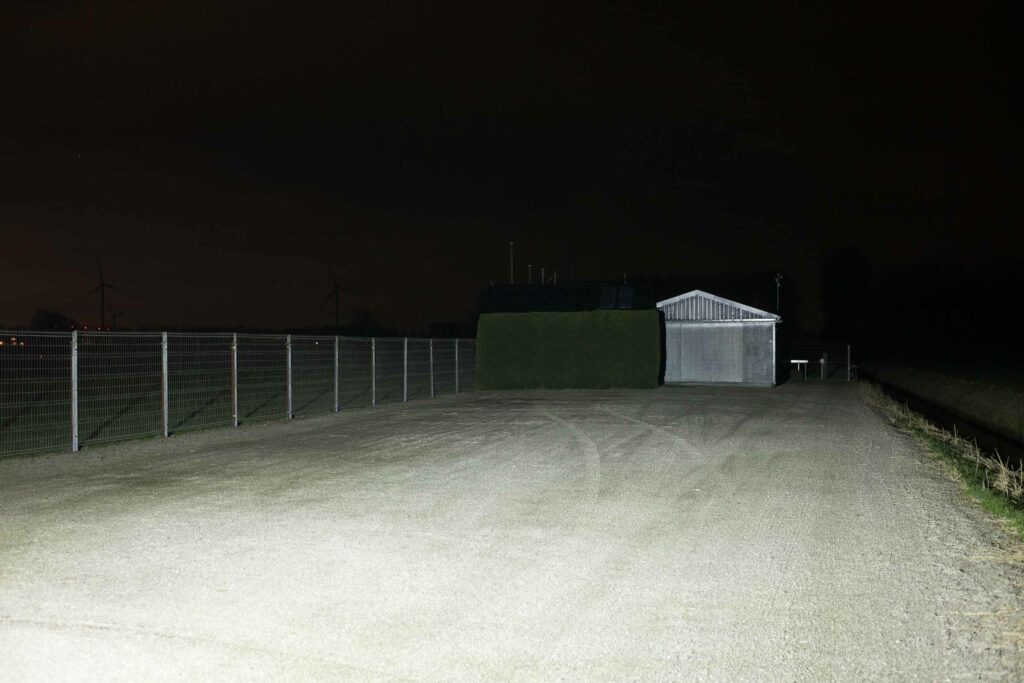
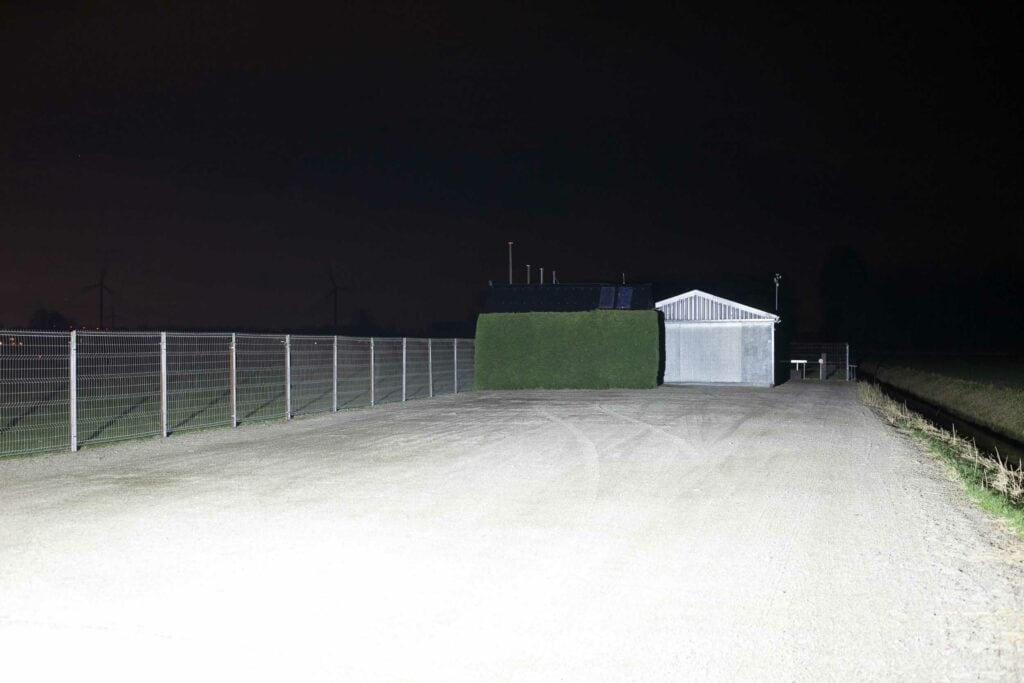




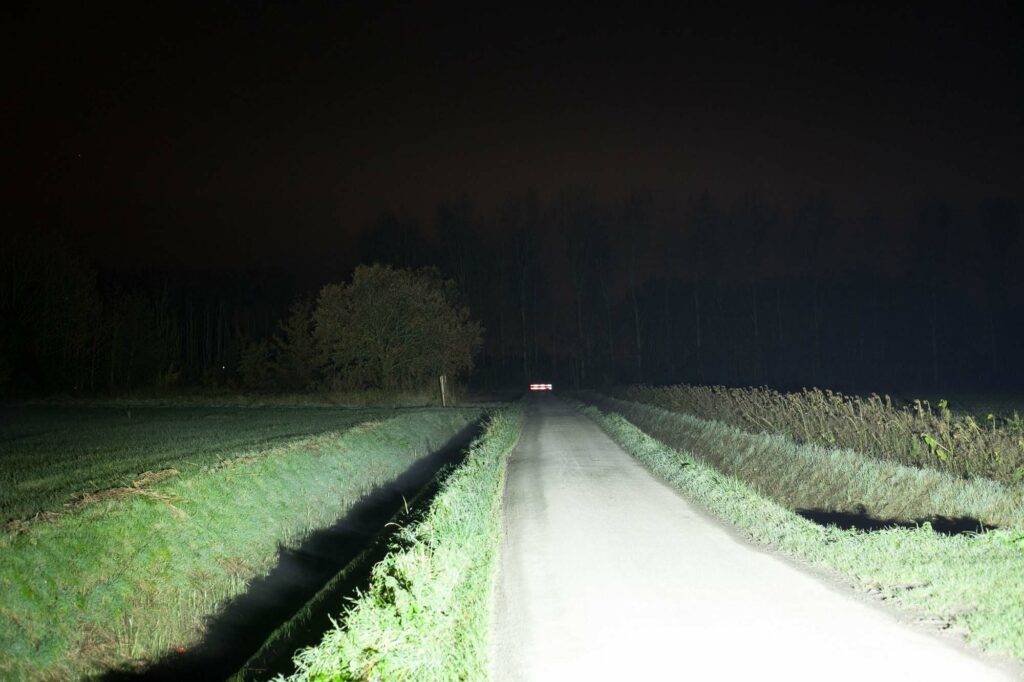
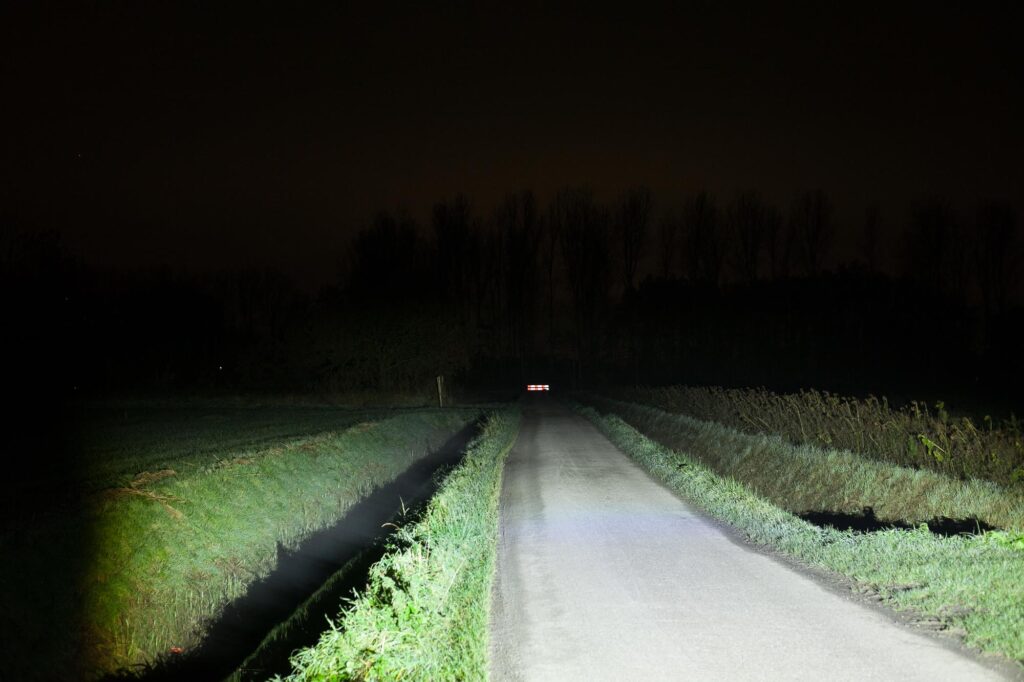
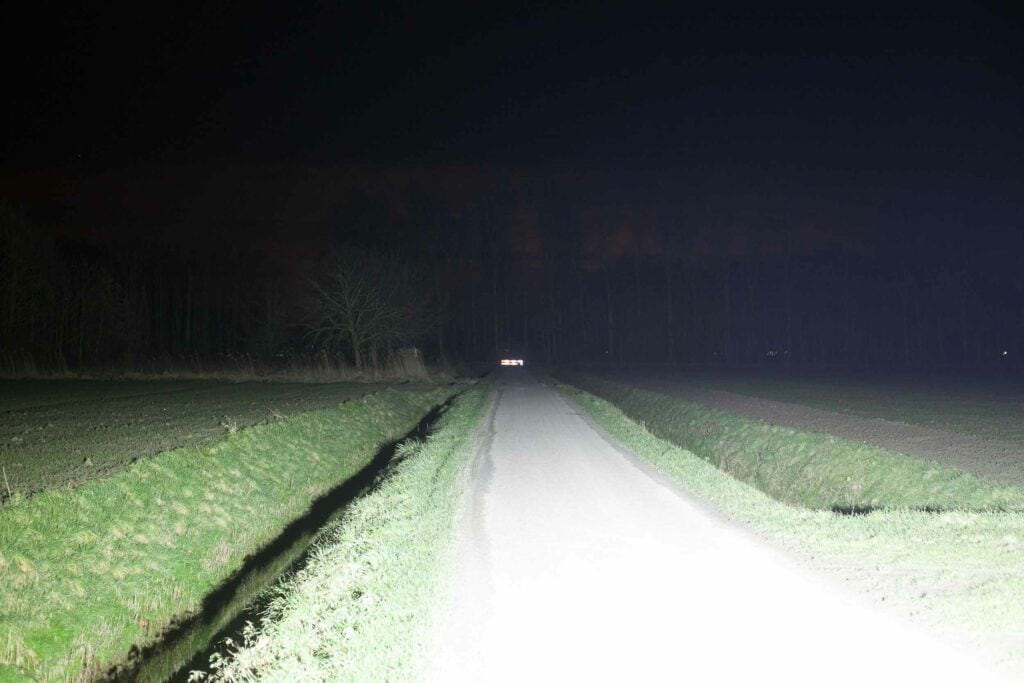




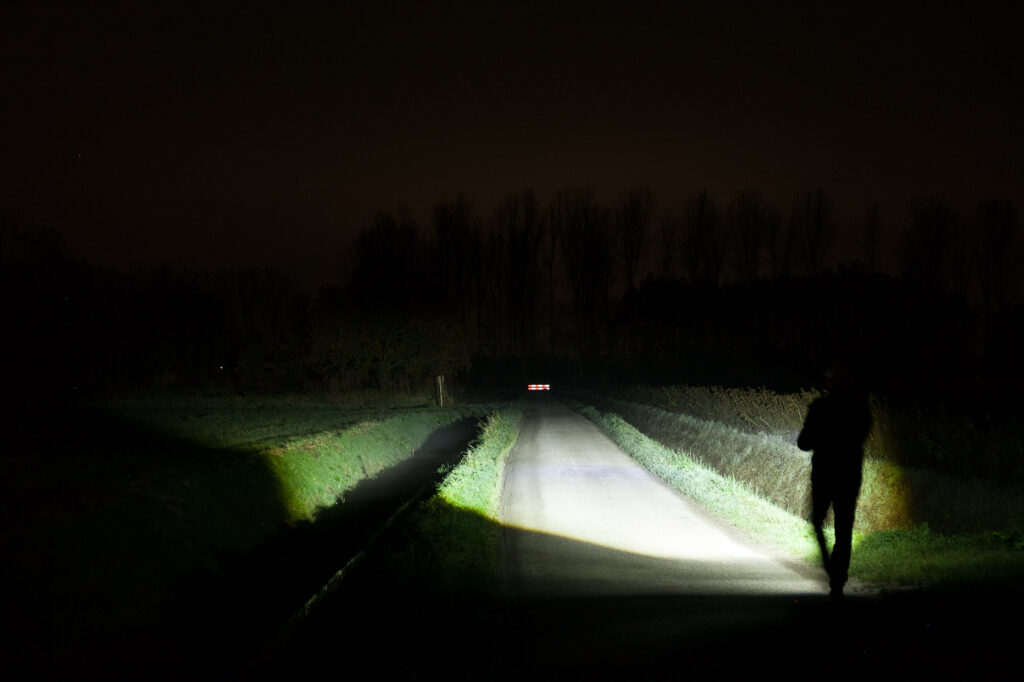
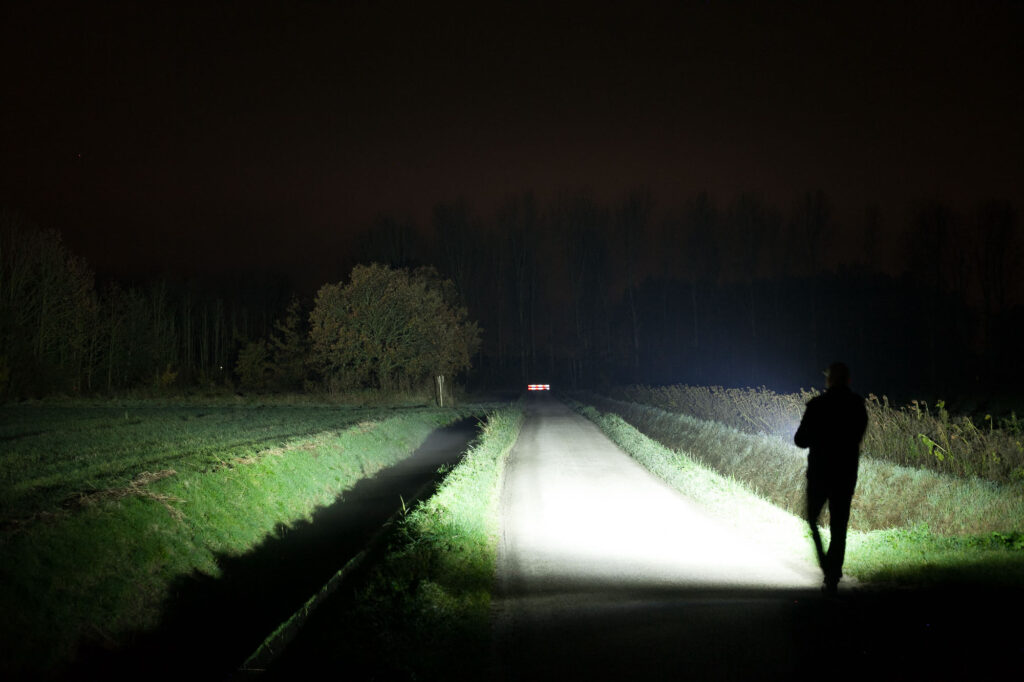
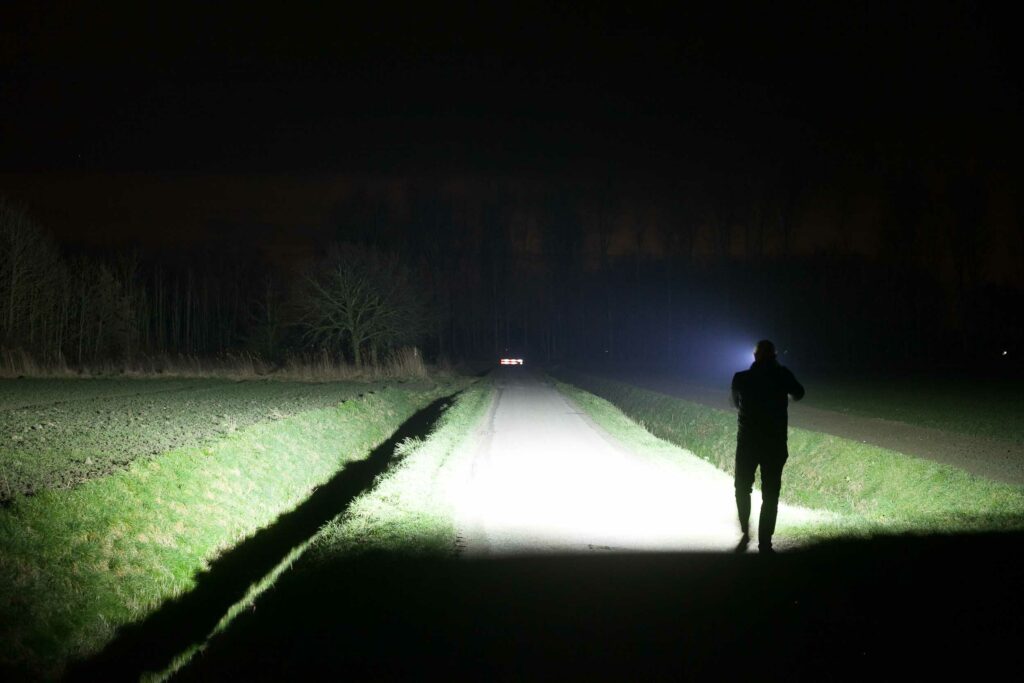
Disclaimer: we bought this flashlight with our own money. Nobody paid us to review this flashlight, nor have we been holding back on problems or defects.
Final Verdict
Pros
- Very bright
- High quality build
- Thermal controlled, so the more cooling, the higher the output
- Lots, and lots of great optional accessories
- Optional double battery connector to double the runtime
- Bluetooth remote control
Cons
- Spectra A kits can have different accessories, so make sure you know what you are ordering
- Not a cheap offering
- Cables are hard to remove when connected (this could also a pro)
- Bluetooth remote only works after activating the light by on the light unit. You can use it to turn off the light, but not to turn it on
Explanation on star ratings:
1: Avoid: my phone flashlight would be a better choice – 2: Poor: significant defect or issues; almost unusable – 3: Average: some defects or issues; but still usable 4: Good: recommended (minor issues) – 5: Great: highly recommended

4 stars: ★★★★
While our star rating provides a reliable indicator, we encourage you to read the full review to make an informed decision based on your own needs and preferences.
These high power headlamps are not meant to be used for jogging or just for fun. They come with a heavy battery pack, and a large headband.
The remove battery pack weighs over 500 grams, making it much heavier than most headlamps out there. But it’s similar to the Olight H67 and Magicshine Monteer 12000 in that regard. Both of those have heavy battery packs as well. And that’s due to the power these high end headlamps require.
To have a Bluetooth remote control is pretty cool, but you can’t turn the light on with it. You can only change modes and turn the light off. I hope Silva can find a solution for that.
I’d recommend double checking all the measurement data in this review before you jump on it. It may be too expensive, or too heavy for your use case. But if you’re looking for something big, powerful, and robust.. you should definitely keep the Silva Spectra into consideration.
If you prefer to use it with a GoPro mount, bike handlebar mount, or a headmount, Silva got your covered. They have plenty of optional accessories to fit everyones needs.
Buy your Silva Spectra A/ Spectra O here
Make sure you order the correct version, either the Spectra A or the Spectra O, and see what accessories are included. This depends on the seller/country.
1lumen selects and reviews products personally. We may earn affiliate commissions through our links, which help support our testing.